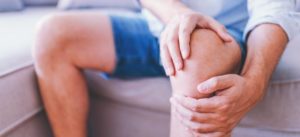Does Your Child Have Knee Pain? Osgood-Schlatter Disease + 7 Natural Pain Relief Remedies
Does your child complain about knee pain? Osgood-Schlatter disease is a common health condition found in growing adolescents, usually those who are experiencing growth spurts. It can be worrying, but when diagnosed and managed well, it can be treated and dealt with in the patient. Here’s what you need to look for, and the natural remedies that will help treat it.
What Is Osgood-Schlatter Disease?
Osgood-Schlatter disease is a condition where the patient experiences knee pain, as a result of growth spurts that change the composition of the knee rapidly. (1) Like scoliosis, it’s most often diagnosed in childhood. It affects the growth plates in the knee, which are areas of cartilage at the end of the bones. Some of these growth plates are attachment sites for tendons in the knee. The tibial tubercle covers the end of the tibia bone, and a group of muscles called the quadriceps are attached to this site.
When children are active, the movement of the knee causes tendons to pull on the tibial tubercle, which can cause it to become inflamed and more noticeable. It will also cause pain in the joint until it is treated.
Signs & Symptoms
How can you tell if your knee pain is related to this condition? Here are the Osgood-Schlatter disease symptoms that you need to watch out for:
- Knee pain and tenderness at the tibial tubercle
- Swelling at the tibial tubercle
- Tight muscles at the front or the back of the thigh. The main symptom is pain, which will be worse when you’re moving and will improve with rest. You’ll develop a small, bony lump just under your kneecap. This will be permanent, but over time, it will become painless. (2)
Can Osgood-Schlatter go away?
In most cases of the disease, Osgood-Schlatter will go away on its own, once you finish growing. This will most often leave you with a small bony lump under your kneecap, but it will become painless. (3)
Is Osgood-Schlatter disease permanent?
In the vast majority of cases, no, it is not. In the small minority of cases, adults may still suffer from the condition as they grow older. This can be treated though, so no matter how old you are, the disease isn’t permanent.
Causes & Risk Factors
The biggest risk factor for getting Osgood-Schlatter disease is simply being young. Children experiencing growth spurts in their teenage years are at risk for the disease as their bones and muscles are still developing. (4)
You’re more at risk if you’re particularly active. This is because the more activity you’re doing, the more your tendons are pulling on the tibial tubercle, causing inflammation and pain. School sports and gym activities are the main culprits for causing Osgood-Schlatter disease. If you’re involved in sports as a young person, then you’ll want to keep an eye out for this condition. It’s common, and so you’re at risk of developing it.
Osgood-Schlatter disease in adults is less common but does still occur. It’s usually a continuation of the condition from when the patient was a child. More often than not though, the condition goes away once the patient has stopped growing and the growth plates harden.
Conventional Treatment
When you’re diagnosed with Osgood-Schlatter disease, there can be some worry. What can Osgood- Schlatter lead to? As already discussed, the condition often goes away on its own, as the patient grows up. In some circumstances, Osgood-Schlatter disease surgery can be needed if the bones and tendons don’t heal correctly. This is quite rare, though, as most patients find that it heals on its own.
In conventional treatment, usually the condition is treated with over-the-counter painkillers to help manage the pain when the joint has been used recently. (6)
If the patient wants to minimize the problems they’re experiencing with their knee, then they can use ice packs to reduce swelling around the joint both before and after exercise. RICE, or rest, ice, compression, and elevation, can all help reduce the symptoms when you’re having a flare-up. Many sufferers use this in between games or activities, to ensure that they’re not doing further damage to their joints.
Do knee braces help Osgood-Schlatters? A good brace can help reduce pain and swelling when your knee is being used. Wearing one when you’re resting, or during athletic activity, can help reduce your symptoms.
7 Natural Remedies for Osgood-Schlatter Disease Symptoms
What is the best way to treat Osgood-Schlatter disease naturally? There are a few natural remedies you can try to relieve the symptoms of Osgood-Schlatter disease, if you’re looking for alternatives. Here are a few that you should try out for yourself:
1. Try an Epsom salt bath
There are some natural options to over-the-counter painkillers that you can try. For example, soaking in an Epsom salt bath is a good way to relieve the pain in your joints, especially your knee. (7)
2. Ingest more collagen
Collagen is the material that allows you to move your joints with ease — meaning you can move your joints smoothly without pain. If you take in more collagen, then studies indicate that it can help with activity-related joint pain. (8) Think of it like fixing a creaky hinge: if you’re adding more grease, then the joint should move more smoothly!
3. Use peppermint oil
Peppermint essential oil can be used to help treat Osgood-Schlatter disease. It’s known to be an effective natural painkiller and muscle relaxant. Studies have indicated it’s particularly useful in tension headaches and joint pain, so you can try using it to treat the pain and inflammation that comes with this condition. (9)
4. Stretch before activity
If you’re involved in sports, then you’ll know that you need to stretch before playing to protect your body and joints. What stretches to do for Osgood-Schlatter? You should be looking for stretches that focus on your quadriceps. These muscles are designed to bend and flex your knee joints, and by taking care of them you’re reducing the pressure on your knees. Look for Osgood-Schlatter disease exercises that are designed to help minimize pain and reduce the pressure on your knee joints. (10)
5. Try bone broth
What you eat has a massive impact on your body, and that includes your knee joints. If you’re living with Osgood-Schlatter’s disease, then bone broth can help treat the symptoms. It contains many different ingredients, with nutrients such as magnesium, silicon and calcium, that can otherwise be found in specialist joint supplements. By drinking broth, you can take in those ingredients naturally and help your joints.
6. Dry needling
Putting needles into your skin sounds like the last thing you want to do if you’re in pain. However, dry needling can help you with the symptoms of this disease. It targets trigger points, alerting your body that there’s an issue, and kick starts your immune system into fighting the problem.
7. Eat spicy foods
If you already love spicy food, then you’re in luck. Spicy foods have been indicated in studies to relieve pain in the human body. (11) This is because they contain capsaicin, a natural painkiller that has been found to help with joint pain.
Prevention
There are ways you can prevent Osgood-Schlatter disease from becoming a problem in your knee joints.








